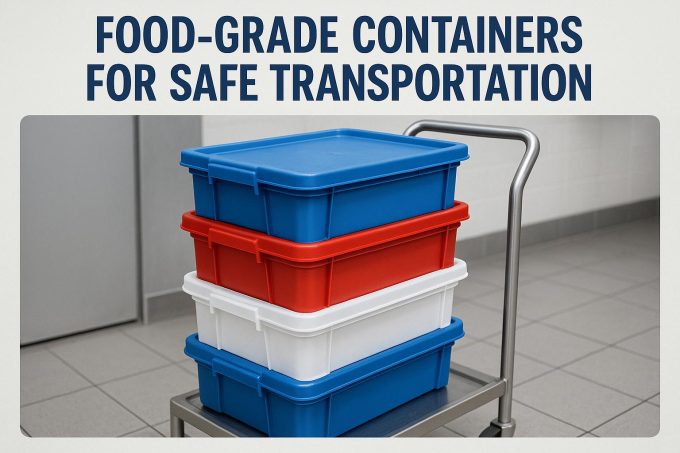Importance of Food-Grade Containers in Safe Transportation
Food safety represents a crucial aspect in the transportation industry, especially when it involves preventing contamination and ensuring the integrity of food products. The use of food-grade containers serves as an effective approach to addressing these concerns. Such containers are engineered specifically to comply with health and safety standards required for the transportation of food items.
What Are Food-Grade Containers?
Food-grade containers refer to containers that are specifically designed and manufactured to safely hold food products without introducing harmful substances. Crafted from materials confirmed as safe for direct contact with food, these containers gain validation from various regulatory bodies worldwide. During their manufacture, critical factors such as material type, durability, and non-reactivity to food substances are meticulously considered.
Materials Used in Food-Grade Containers
Various materials are employed in the production of food-grade containers, ensuring suitability for different types of food items. Common materials include plastics, stainless steel, and glass, each possessing unique properties that render them apt for specific applications:
Plastics:
Food-grade plastics such as polyethylene and polypropylene are favored for their flexibility and lightweight nature. Yet, it is crucial that they remain BPA-free to guarantee safety. These plastics are ideal as they do not impart any odors or tastes to the food they store. Furthermore, they can be molded into various shapes and sizes, accommodating a wide range of food items.
Stainless Steel:
Known for its robustness and corrosion resistance, stainless steel stands out as a suitable choice for transporting perishable food items requiring insulation from external variables. Its durability ensures that it can withstand significant physical stress without compromising its structural integrity, making it a preferred material for professional kitchens and food-service operations.
Glass:
Though inherently fragile, glass boasts complete inertness, meaning it will not react with the food it holds. This makes it particularly suitable for storing acidic foods. Additionally, glass containers offer a clear visual of the food without needing to open the container, thereby reducing the risk of contamination.
Compliance and Standards
The implementation of food-grade containers is subject to stringent regulations to avert contamination risks. For instance, in the United States, the Food and Drug Administration (FDA) promulgates standards for materials that come into contact with food. Meanwhile, in Europe, the European Food Safety Authority (EFSA) delineates standards for the safe transportation of food.
Ensuring compliance with these standards necessitates regular testing and certification by relevant authorities. Companies engaged in food transportation must verify that their containers conform to all essential requirements and maintain appropriate documentation to corroborate compliance. This is not merely a procedural mandate but a commitment to public safety and the maintenance of product quality.
Benefits of Using Food-Grade Containers
The primary advantage of utilizing food-grade containers lies in the assurance of food safety during transportation. These containers act as a barrier against contamination, preserve freshness, and enhance the overall quality of food products upon reaching their destination. In addition, they help to maintain the nutritional value of food items by minimizing exposure to environmental hazards, such as moisture and air exposure.
Food-grade containers also contribute significantly to the sustainability of supply chain operations. By reducing spoilage and waste, they ensure more efficient use of resources. In the long run, this can yield both environmental benefits and cost savings for businesses.
The durability and reusable nature of many food-grade containers further expand their benefits. Proper care and maintenance allow these containers to be used multiple times, which aligns with sustainability goals by reducing the need for single-use packaging solutions.
Challenges in Using Food-Grade Containers
Despite their numerous advantages, the deployment of food-grade containers is not without challenges. The initial cost of investing in high-quality, compliant containers can be significant. Companies must balance the upfront costs against long-term benefits, which, though substantial, can be difficult to quantify immediately.
Additionally, keeping abreast with ever-evolving regulations requires constant vigilance. Companies must invest in training and systems to ensure ongoing compliance, which can introduce operational complexities.
The maintenance of food-grade containers, while typically minimal, still demands attention. Regular inspections and cleaning, in accordance with recommended guidelines, are essential to preserve their integrity and efficacy.
Impact on Supply Chain Efficiency
The incorporation of food-grade containers into the supply chain can enhance overall efficiency significantly. By minimizing spoilage and contamination risks, these containers ensure that a higher percentage of transported food reaches its destination in optimal condition. This reliability fosters trust among consumers and partners, reinforcing the reputation of businesses as proponents of food safety.
Efficient utilization of food-grade containers can lead to more streamlined logistics operations. Properly selected and managed containers facilitate better utilization of transportation space, enhanced stacking, and optimized temperature control, all of which contribute to a reduction in both transportation time and costs.
Conclusion
The significance of food-grade containers in the transportation industry is undeniably profound. They play a vital role in safeguarding public health, ensuring compliance with regulatory standards, and preserving the quality of food products. For those seeking more detailed information regarding food-grade containers and their regulatory frameworks, exploring industry-specific websites can offer valuable insights and resources.
In essence, food-grade containers constitute a critical element within the food industry supply chain, ensuring that products reach consumers in a safe, consumable state. Businesses that prioritize the use of such containers not only demonstrate a commitment to quality and safety but also position themselves advantageously in a market where consumer trust is paramount.

